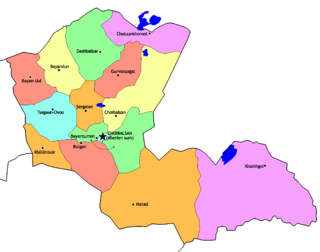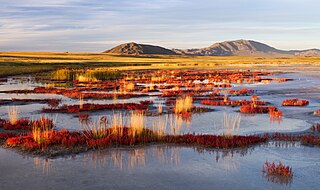This article needs additional citations for verification .(December 2015) (Learn how and when to remove this template message) |
Coordinates: 48°59′48″N102°44′09″E / 48.99667°N 102.73583°E

A geographic coordinate system is a coordinate system that enables every location on Earth to be specified by a set of numbers, letters or symbols. The coordinates are often chosen such that one of the numbers represents a vertical position and two or three of the numbers represent a horizontal position; alternatively, a geographic position may be expressed in a combined three-dimensional Cartesian vector. A common choice of coordinates is latitude, longitude and elevation. To specify a location on a plane requires a map projection.


The Uran Togoo - Tulga Uul Natural Monument (Mongolian : Уран Тогоо - Тулга уулын дурсгалт газар [1] ) is a national protected area in the Bulgan Province of Mongolia. It is located about 60 km directly west of Bulgan city around the extinct volcanoes Uran Togoo, Tulga, Togoo, and Jalavch Uul.

The Mongolian language is the official language of Mongolia and both the most widely-spoken and best-known member of the Mongolic language family. The number of speakers across all its dialects may be 5.2 million, including the vast majority of the residents of Mongolia and many of the Mongolian residents of the Inner Mongolia Autonomous Region. In Mongolia, the Khalkha dialect, written in Cyrillic, is predominant, while in Inner Mongolia, the language is dialectally more diverse and is written in the traditional Mongolian script. In the discussion of grammar to follow, the variety of Mongolian treated is Standard Khalkha Mongolian, but much of what is to be said is also valid for vernacular (spoken) Khalkha and for other Mongolian dialects, especially Chakhar.

Bulgan is one of the 21 aimags (provinces) of Mongolia, located in northern Mongolia. Its capital is also named Bulgan.

Bulgan is a town, administrative centre of Bulgan province of Mongolia. Bulgan sum has a population of 11,984, 12,323 (2008), town proper has a population of 11,198 (2008). It is located at the site of the former Daichin Wangiin Khüree monastery at an elevation of 1,208 metres (3,963 ft) and 468 kilometres (291 mi) from Ulaanbaatar.
All four mountain names allude to their volcanic past with designations borrowed from around the fireplace. The Uran Togoo and Togoo mountains are named for their bowl shape, the Tulga mountain for its three mounds reminding of the traditional iron tripod kettle support. Jalavch is a term for a small pot. [2]
The area is situated in the Khutag-Öndör district of Bulgan Province. A smaller area was initially protected in 1965 by State Great Khural Resolution No. 17. In 1995, it was designated as a monument by Parliament Resolution No. 26 with an area of 5,800 hectares.

Khutag-Öndör is a sum (district) of Bulgan Province in northern Mongolia.

The State Great Khural is the unicameral parliament of Mongolia. It is located in the Government Palace.









